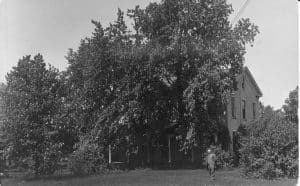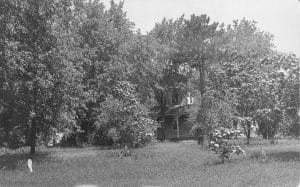Local History
Crystal Lake Academy Building History
The Crystal Lake Academy
In November 1853, a Warranty Deed was filed with McHenry County indicating James T. Pierson and his wife Mary C. Pierson transferred title for the Northwest Quarter of Section 5, Range 8 in Algonquin Township to the following individuals: Beman Crandall, M.F. Irwin, M.A. Smith, S. Gates, Solomon Keyes, Allen Baldwin, Josiah Walkup, J.T. Pierson, Irwin G. Salsburg G.A. Palmer, Thomas Ford and Christopher Walkup. Prior to this (1851),
James T. and Mary C. Pierson had acquired ALL of Section 5.

Left: James T. Pierson. The Pierson’s lived in a cobblestone house which was built by local stone mason, Andrew Jackson Simons. Their house was on Virginia Street (Route 14) just west of today’s Dole Avenue. Most likely Pierson’s personal connection with Simons would lead to his contract to build the Crystal Lake Academy building.
The twelve grantees in the above transaction were the Trustees for the Crystal Lake Academy in 1853. The Crystal Lake Academy was established twelve years earlier, in 1845, in the regular session of the Fourteenth General Assembly of the State of Illinois (copy attached). Of the twelve Trustees named in 1853, four of them (Crandall, Irwin, Pierson, C. Walkup) were named as Trustees in the incorporating documents of 1845. It is unknown where the Crystal Lake Academy held classes from 1845 to 1853.
Section 11 of the incorporating documents provides that, “No sectarian principle shall be taught by any of the professors, tutors, trustees, or any officer connected with said institution either in regard to religious or political tenets, to any of the students, and said institution shall be open to all denominations of Christians, and any profession of religious or political faith, shall not be required of those to become students.”
An exact date of the Academy Building’s completion is difficult, if not impossible. Records simply do not exist. It is highly likely the building was completed ca 1853 when the property was transferred to the Crystal Lake Academy Trustees.
The Academy Building was constructed by Andrew Jackson Simons. Simons was born March 24, 1829. In 1848, he came to McHenry County from Livingston County, New York. Simons was a stone mason by trade.

Left: Andrew Jackson Simons. Builder of the Crystal Lake Academy and other cobblestone structures in Crystal Lake. Photo courtesy of the McHenry County Historical Society
Andrew Jackson Simons Click on link to learn more about Simons and the nine known cobblestone buildings he built in Crystal Lake.
Simons learned his trade in New York State and brought his skills to McHenry County. The use of cobblestones as building materials was quite popular in the Genesee Region of New York State which includes Livingston County. Cobblestones in the area were glaciated cobbles (formed by glaciers). They are abundant throughout central and western New York State and became a popular building material in the early to mid-1800s. More than 700 cobblestone structures were built in this area of New York State. New Yorkers, such as Andrew J. Simons, carried the craft west. According to the book, Cobblestone Landmarks of New York State, the second largest group of American cobblestone buildings appeared in the 1840s and 1850s on both sides of the Illinois-Wisconsin border. This includes Crystal Lake.
Cobblestones used for construction in Illinois required a bit more work to obtain. Each wagonload of cobblestones represented a three-day trip. On the first day, the builder would travel to the shores of Lake Michigan, usually near Waukegan, with a wagon filled with grain or other items to sell. The second day was spent collecting stones to fill the emptied wagon. The stones selected and used were about fist-sized and smooth, varying in color. On the third day, the builder would return to Crystal Lake with a full wagonload of stones for the construction project. It took numerous wagonloads of stones to complete the foundation of the Crystal Lake Academy Building.
Simons is credited with building four cobblestone houses in and around Crystal Lake. Two of these houses have been demolished (Pierson House and Pingry House). The two cobblestone houses still standing are landmarked under protective ordinances. They are the Columbus and Hannah Beardsley Wallace House, built ca 1851 (City of Crystal Lake Landmark) and the John Walkup House, built ca 1856 (McHenry County Landmark). Similar to the Academy Building, Simons is credited with building several brick homes with cobblestone foundations which still stand, including the Ellsworth House and the Colonel Palmer House (both located on today’s Route 176). The Colonel Palmer House was built in 1858 and is on the National Register of Historic Places. It is also landmarked under the protective Historic Preservation Ordinance of the City of Crystal Lake.
All of the known local structures credited to Andrew Jackson Simons were built in the 1850s. Simons served in the 36th Illinois Infantry, Company H (1861-1865) during the Civil War. The 36th Illinois Infantry fought in the battles of Pea Ridge, Perryville, Stones River, Chickamauga and Missionary Ridge. After returning from the War, he suffered from rheumatism which caused him to walk with a cane and slowed down his house-building career.
The Crystal Lake Academy building is a combination of Greek Revival and Federalist architecture. Greek Revival components of the design include the gable-end entry. This front-gabled roof subtype is common in the Midwest and was popular until 1860. The building was oriented so that the front entrance faces Grove Street. Other characteristics of the Greek Revival style are the heavy sills and lintels which are of dressed limestone for the windows and doors. The Federalist characteristics include a low-pitched roof with heavy cornice and broken pediment returns at each gable. The tall six-over-six windows arranged in a highly regular fashion and the lack of ornamentation are also Federalist characteristics.
An early drawing of the building (1872) indicates a large wrap-around porch. This porch has been replaced with a smaller square porch at each door. The front entrance porch is supported by prominent columns. Another Federalist-style feature is the front door flanked by narrow sidelights.
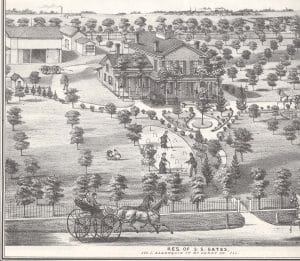
Left: Lithograph showing residence of S. S. Gates, Algonquin Township. 1872 Combination Atlas of McHenry County, Illinois. Published by Everts, Baskin & Stewart.
Simons’ signature cobblestone foundation is most prominent on the front (Grove Street side) of the house. The mortar joints, both vertically and horizontally, are of a raised bead-style lending the appearance of each set cobblestone to be in a recessed rectangle. The red bricks used for constructing the walls match the ones used for building the Colonel Palmer House, which Simons built in 1858. It is believed the bricks were manufactured of local clay at a factory previously located north and east of the village (later becoming the site of the American Terra Cotta & Ceramic Co. owned and operated by William Day Gates).
The construction of the Crystal Lake Academy was likely a great source of pride for the community. The Crystal Lake Academy provided higher education (above 8th grade) to students from Crystal Lake families who could afford the tuition needed to operate the private school. There are no known student or teacher records that exist today. From newspaper articles, obituaries, biographies and other sources, we have been able to identify a number of students and members of the Academy’s Debating Club and Literary Society Members. These students include: H.T. Baldwin; F. Barthell; E.A. Beardsley; D.C. Bradley; Martha Josephine Buck; Ira J. Chase (later became Governor of Indiana); B.F., Laura and Oscar Crandall (children of Beman Crandall, first settler of Crystal Lake); C. and Nancy Goodspeed; Lawrence W. Halsey (nephew of James T. Pierson and later became a Judge in Wisconsin); Edward and Henry H. Hayden; C.W. Hugh; T. Ingersoll; Herman B. and Sam Jackson; W. Norton; David and Mary Salisbury; C. Shepley; M.L., S.R. and W. Shoemaker; C.W. Smith; Wm. P. St. Clair; Evaline Mary Walkup (daughter of John B. Walkup); Mary and Sarah Wallace (daughters of Hannah Beardsley); F.L. West; and Flavia Williams.
The known teacher list is even smaller: Professor Lebeus L. Smith. In 1858, D.S. Knight is listed as Principal and was most likely a teacher as well.
The eventual demise of the Crystal Lake Academy began in 1855 when The Illinois School Law established a free public school system in the state. This law established a state school tax to help fund the schools. It also allowed for local taxation in addition to the state tax. AND it provided for free schools in every district for six months of the year. This assured that students, regardless of financial position, could get a free, quality education. Many parents decided to discontinue paying tuition. Debts piled up for the Academy while income from tuition dried up.
In May 1858, a mortgage on the property was filed with the County Recorder. The Crystal Lake Academy was in debt to William Baker. The money may have been an advance for the Academy’s eight-week summer term, which was advertised in the May 18, 1858 Woodstock Sentinel (below). A September 1858 notice in the same newspaper (below) announces that William Baker demands payment from the Academy. Recourse for non-payment would be the reclamation and sale of the property. A Certificate of Sale (foreclosure) by the Crystal Lake Academy to William Baker was filed with the County Recorder in November, 1858.
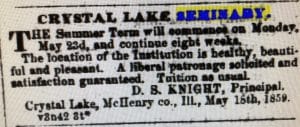
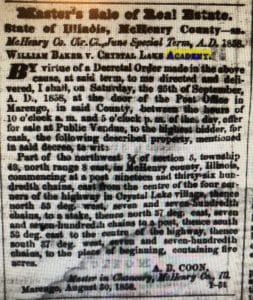
Simon S. Gates Ownership
In March 1860, Simon S. Gates gained title to the former Crystal Lake Academy building and surrounding 6.5 acres of land, as evidenced by a Masters Deed filed with the McHenry County Recorder. Consideration listed is $816.
Simon S. Gates, one of ten children, was born October 1, 1799 in Stockbridge, VT. He was raised in Worcester, MA and it was there that he grew up to receive an excellent education. In the Spring of 1838, Simon visited McHenry County on a prospecting tour. He returned in the Fall, the entire journey being made on horseback. The next year, he returned to Crystal Lake and made several land investments. Simon returned to his home and was elected to the Massachusetts State Legislature.
In 1844, Simon married Miss Sylvia Day. Simon and Sylvia had three children: Sumner E, William D. and Mary. Simon also had two daughters, Sarah and Abby, from prior marriages. In 1852, the Gates family came West and lived on the farm property bought at Crystal Lake in 1841. Simon Gates steadily purchased other properties throughout the area, and soon became one of the largest landed estate owners in the county.

Left: Simon S. and Sylvia Day Gates. Images from 1885 McHenry County History Book.
The 1860 census indicates Simon S. Gates, his wife Sylvia, and children Abby, Sumner, Willey (William) and Mary were living on a farm in Algonquin Township. Also listed in the household are two female servants and three male farm laborers. The census also reveals the value of Gates’ real estate to be $133,785 and personal estate value of $15,000.
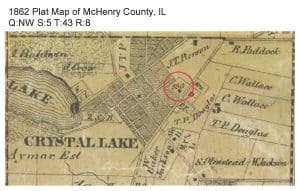
The family moved from the farm to the Crystal Lake Academy building and made it their home. They retained ownership of the farm and other properties.
Left: Red circle shows property belonging to S.S.G. (Simon S. Gates)
In 1864, at age 19, their oldest son Sumner enlisted in Company H of the 8th Illinois Cavalry. During his time of service, Sumner Gates was captured and held prisoner for several months in the dreaded Libby Prison at Richmond, VA. While imprisoned, his health significantly deteriorated. No doubt, his wealthy father had some hand in arranging for the prisoner exchange which brought his son home in 1865. It is said Sumner never fully recovered from his time in prison.
Gates’ other son, William Day Gates, was born in 1853. William grew up in Crystal Lake and went on to become an attorney in Chicago. After his father’s death in 1876, William D. Gates moved back to the Crystal Lake area, investing in the Spring Valley Tile Works factory, which was located northeast of town. The factory was built near a dam on a former mill site. The company’s primary operation was to make bricks and drain tiles from local clay. Most likely the bricks for the Academy Building/Gates House were fired at Spring Valley Tile Works factory. In 1887, fire destroyed the drain tile factory. Gates rebuilt his operation, expanding the clay works and starting the production of decorative, glazed terra cotta. It was at this time that the company name was changed to American Terra Cotta and Ceramic Co.

Left: William Day Gates grew up in the Academy/Gates House on McHenry Avenue (photo from Common Clay)
From a plain drain tile factory, the business grew and began to turn out some of the finest architectural terra cotta known. The great architect, Louis H. Sullivan, once worked there with American Terra Cotta’s own renowned modeler, Kristian Schneider. Between them, they developed the ornamental design for architectural terra cotta known as the Sullivanesque design.
Carloads of architectural terra cotta were produced and shipped out across the nation. Samples of the ornamental works can be found on several buildings in Chicago, including the famous Wrigley Building on Michigan Avenue. The exterior of the Yerkes Observatory in Williams Bay, WI is clad in ATC&C terra cotta. Downtown Crystal Lake also has several buildings with architectural terra cotta, including the Teckler Building, Warner Building, United State Bank Building, and Raue Center for the Arts.
In addition to architectural terra cotta, the company also produced decorative pottery known as TECO pottery. Today, these ornamental pottery vases are in demand as collectible and are very valuable.
The 1870 Census shows Simon, Sylvia, Sumner and Mary living in the house on McHenry Ave.
Simon Gates died on June 24, 1876. At the time of his death, his estate was valued at over a half-million dollars, a huge amount of money for that time. It took over a dozen years for Simon S. Gates’ estate to be settled.
Simon, Sylvia, daughter Abby, sons William and Sumner, as well as many other Gates family members are buried in the Crystal Lake Cemetery on Lake Avenue. An impressive monument marks the Gates family site.
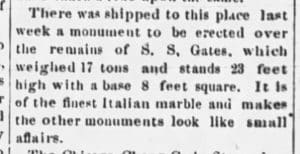
Left: McHenry Plaindealer May 29, 1878
The Crystal Lake Cemetery was consecrated in 1840 and is the first public burial ground in Crystal Lake. It is landmarked under the protective Historic Preservation Ordinance of the City of Crystal Lake. Its landmark status was obtained by its age and it being the final resting ground for many of Crystal Lake’s early settlers including these notable names associated with the Crystal Lake Academy property: Beardsley, Buck, Crandall, Ford, Gates, Ingersoll, Keyes, Palmer, Pierson, Shoemaker, Simons, Smith and Wallace.
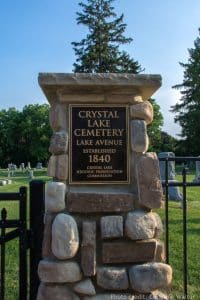
 Left: Landmark Plaques at Crystal Lake Cemetery
Left: Landmark Plaques at Crystal Lake Cemetery
Katie Gridley Jones Ownership
In March 1883, Katie Gridley Jones of Chicago acquired the property from the now-settled Gates estate. Consideration was $3,850.
Katie Gridley Jones was the third wife of Henry T. Jones, a successful brick manufacturer from Chicago. His firm provided the bricks to build the Palmer House (Chicago), Grand Pacific Hotel, The Tremont House, Cook County Hospital, and other prominent Chicago buildings.
It was not uncommon for businessmen to title property in their wife’s name to protect the investment in the event of a business downturn. This appears to be the case with Mr. and Mrs. Jones, as they both travelled back and forth between their home/business in Chicago and their Crystal Lake home, the former Crystal Lake Academy building.
Work on their new home began immediately after purchase. The April 6, 1883 Herald indicates, “The man who purchased the Gates place at C. Lake will put an $800 fence in front of it and fix it up nicely.” Two weeks later, this mention occurs, “I. Miller has three hands to work for him. He has taken the job of painting the Jones house and barn, formerly the Gates house of C. Lake.” The June 1, 1883 Herald mentions, “Mr. H. Jones’ new iron fence is a beauty.” It is believed the iron fence that currently runs along McHenry Avenue property line is the one built in 1883 by H.T. and Katie Jones.
In 1884, H.T. Jones paid $1,000 to expand his property west to Division Street. He now owned the whole block.
Within a few years, both Katie and Henry were active members of the Crystal Lake community. Both worked to better the village’s education system. In 1888, the new Union School was built down the road from the Jones’ home. Katie was especially active with the WCTU (Women’s Christian Temperance Union), serving as the chapter president for many years. Henry retired from full-time business in 1888.
In 1893 and 1897 H.T. Jones was elected and served as President of the Village of Crystal Lake. Henry T. Jones died in 1898 at the age of 75. His widow, Katie Gridley Jones was 42 at the time. She continued to live in Crystal Lake for the next few years, raising Angora cats as a side business. By 1901, Katie is back in Chicago and renting out her Crystal Lake home.
Alonzo B. Lucas Ownership
Katie Gridley Jones sold the property to Alonzo B. Lucas in 1904. Consideration was $4,000.
The 1900 census lists Alonzo B. Lucas, his wife Mary, two daughters, one son and four servants (possibly farm hands) living on a farm in Algonquin Township. Four years later, Lucas gave up farming and moved to town.
Beginning in 1905, Lucas started selling off part of his Crystal Lake property along Division Street. This is the portion of the block that H.T. Jones purchased in 1884.
The Lucas family was active in the Nunda Christian Church. Like the former owner, Katie G. Jones, Alonzo B. Lucas was a strong advocate against intoxicating liquors (alcohol).
The 1910 census shows Alonzo Lucas, his wife and three grown children (all in their 20s) living in the home on McHenry Avenue. Alonzo’s profession is listed as “Driver”, one daughter is a “Seamstress” and the son’s occupation is “Lineman for Phone Company”.
In April 1911, the newspaper reports that A.B. Lucas and several others are travelling to Pharr, Texas with the intent to purchase farmland. Evidently, Lucas made an investment in Texas land but was soon disappointed when he went to visit his place in June and discovered his property was underwater and not tillable.
At the same time, his property in Crystal Lake was deeded over to Andrew Henderson (local banker) and put up for sale.
The following photographs were provided by Major F. Gates, great-grandson of Simon S. Gates. The photos show the Crystal Lake Academy property when it was for sale in 1911/1912. The real estate agent was C.L.Teckler. Despite the overgrown condition of the property, one can peek at the house to see the original porch on the McHenry Avenue side of the house and see the original north wall of the house with its beautiful bay window. One also has a good view of the black iron fence, built in 1883 along McHenry Avenue.
William J. Nye Ownership
The Academy/Gates House and surrounding land was purchased by William J. Nye as a summer home for his family. The Nye family’s main residence was in Oak Park. William J. Nye was a grain dealer and a member of the Chicago Board of Trade.
In February 1912, the Herald reported that, “G.D. Crabtree and men are remodeling the interior of the old A.B. Lucas home.” Crabtree was a well-known skilled carpenter in Crystal Lake. By July 1912, it was reported, “W. Nye of Oak Park, who recently purchased the Lucas place, has made extensive improvements and alterations on his property.”
For the next eight years, the Nye family alternated between their homes in Crystal Lake and Oak Park, depending on the season. Mrs. Nye, especially, became very active in the community as a member of the Women’s Improvement Club and Ladies Aid Society of the First Congregational Church.
In 1916, over 100 invited guests attended a musical concert in the Nye’s home on McHenry Avenue to benefit the Ladies Aid Society. Five members of the famous Paulist choir sang the Hallelujah Chorus. Other vocal musical selections as well as piano and violin performances entertained the audience. Cake and ice cream were served after the concert. The newspaper reported, “a substantial sum was added to the treasury of the Congregational Ladies’ Aid Society as a result of this successful affair.”
The Nye’s sold their summer home in November 1920.
Frederick B. Mathis Ownership
The new owners of the Academy/Gates House were Frederick B. and Lillian O. Mathis. Although only 41 years of age, Fred had recently retired from his career as General Manager for Excelsior Motor Mfg. Co. in Chicago due to health issues. Fred and Lillian had two teenage children: Rosalind (13) and Fred Jr. (11).
With the children in school, Fred and Lillian quickly found clubs and activities to keep them busy. Lillian became a member of the Women’s Improvement Club, while Fred joined the Community Club. From 1923 to 1930, Fred served as president of the Community Club. In 1924, he was elected President of the District 47 Board of Education, retaining that position until 1932. Public service was in his blood! Fred served as Alderman for the City of Crystal Lake from 1924 to 1927. In April 1927, he was elected Mayor of Crystal Lake.
During his time as Mayor, Crystal Lake was the first city in the county to adopt a zoning ordinance. An aggressive paving program, first started by Mayor Ben Raue, was continued under Mathis, and the Franklin Street well was dug while Mathis was Mayor.

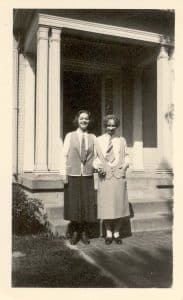
Left: Fred B. Mathis, Mayor of Crystal Lake
Right: Rosalind Mathis and her friend Evelyn Allen on the steps of the Mathis home – ca1925
The Mathis children attended Crystal Lake Community High School. Rosalind graduated in 1925, Fred Jr. graduated in 1926. In October 1926, Rosalind Mathis married Major E. Gates, son of William Day Gates and grandson of Simon S. Gates (prior owner of the Academy/Gates House property). The couple moved in with Fred and Lillian, raising their two children, Major F. and Nancy in this multi-generational household.

Left: Rosalind and Major E. Gates with friend Evelyn Allen. Their son, Major F. Gates is on the sled.
For several years, Fred and Lillian travelled to California during the winter months. By 1941, they decided to stay in California year-round.
Rosalind Mathis Gates Ownership
The Academy/Gates House property was deeded to their daughter, Rosalind Mathis Gates in 1941 for $1 and with this additional consideration—when the parents aged and needed her help or care, Rosalind would leave Illinois and move to California to care for them.
In the meantime, Rosalind was active in the community, being credited with bringing Girl Scouts to Crystal Lake.
For six years, only Rosalind, Major E., Major F. and Nancy Gates lived in the home. In 1947, Rosalind was called to California to care for her parents and the property went up for sale.
St. Mary’s Episcopal Church Ownership
Prior to 1947, St. Mary’s Episcopal Church (formerly known as “St. Mary’s-by-the-Lake”) was located in a converted 6-car garage on Oriole Trail. The Episcopal Church Diocese of Chicago, of which Bishop Conkling was in charge, made an offer on behalf of the congregation of $40,000 to purchase the property from Rosalind Mathis Gates. The offer was accepted.
According to the Herald, “The plan was to use the large and beautiful residence for Sunday school, church classes, junior activities and a residence for the Rev. Donald Platt, priest-in-charge.”
The August 7, 1947 Herald includes a detailed description of the building’s interior, its excellent condition and how the layout could work well for the Church. The Herald continues, “Members of St. Mary’s-by-the-Lake look upon the acquisition of the Fred B. Mathis property as much in terms of community interest as of their own church development. They will welcome other groups in Crystal lake to take advantage of it when it becomes available for use. Property of this kind, in a sense a product of the community, deserves to be administered according to a standard of public responsibility. For this reason, too, there is a sincere hope that it will not be necessary to sub-divide it or in any way to destroy its distinctive character. St. Mary’s-by-the-Lake wishes thus to serve as a custodian for one of the old landmarks of Crystal Lake.”
The Crystal Lake Academy/Gates House building was then renamed, “The Mission House.”
The congregation began planning for a new Church Sanctuary for the McHenry Avenue property. A groundbreaking ceremony was held in November 1957. The building was completed in September 1958. Estimated cost was $100,000. In 1961, a Rectory was built.
According to a church history, “In 1964, the Mission House was renovated at a cost of $18,000, making the house much more usable for church school classes and other church activities.”
In 1972, the Mission House was renamed, “The Rev. Kenneth J. Tarpley House,” in memory of the Rev. Mr. Tarpley, who served his parish well both as a layman and as a Deacon for several years. Mr. Tarpley was also a teacher at Crystal Lake Community High School for over 36 years and was head of the English Department for more than 20 years.
In 1981, Polly Crandall Questers presented a plaque in recognition of the position of Tarpley House in the history of Crystal Lake.
Another large building project began in 1984-85 with a one-story addition to the north side of Tarpley House. An education wing of the church was added, connecting the buildings.
Also in 1985, the church hired Renaissance Restoration, Inc. of Galena, IL to chemically strip off paint, dirt and grime from the brick exterior of the building. The building was then tuckpointed where needed and a sealer applied to keep out moisture. Volunteers worked to paint and redecorate the interior of Tarpley House.
The June 8, 1988 Crystal Lake/Cary-Grove Citizen newspaper includes this quote by Rev. William N. Hoelzel, “I think the parish has a real commitment to maintaining the building and also to try as best as we can to restore it to its turn-of-the-century elegance.”
In 1997, Rev. Hoelzel continues to support the use of Tarpley House for the church and the community. He says, “We feel we need to be there for the community as well as provide space for community groups.”


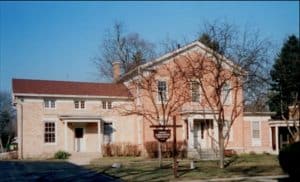

Left to right:
- Undated (circa 1980s?) photograph of Tarpley House
- Closeup view of cobblestone foundation
- 2005 photograph of Tarpley House taken by Harry N. Dillon, long-time church member.
- 2015 photograph of Major F. Gates (grew up in house) and his son Phil Gates on the steps of Tarpley House.
Currently:
In 2024, St. Mary’s Episcopal Church applied for a demolition permit for the former Crystal Lake Academy/Gates House/Tarpley House.
An application for landmark status was applied for by local residents.
A public hearing was held before the city’s Historic Preservation Commission on November 7, 2024. The commission unanimously recommended landmark status to City Council.
Crystal Lake City Council is scheduled to make a decision to either landmark the structure or allow demolition on December 3, 2024.


